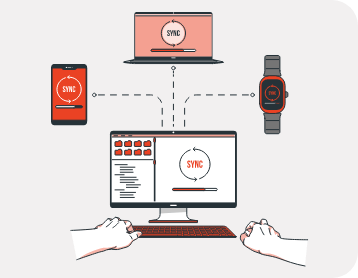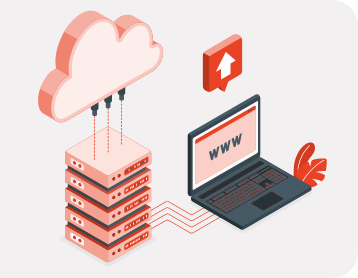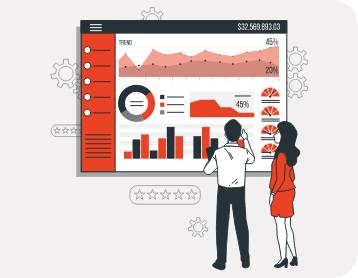Overcoming Cloud Migration Challenges
Effective Resolutions for Cloud Migration
Streamlining Your Transition to the Cloud

In the last 10-15 years, the proliferation of cloud computing has transformed the enterprise tech landscape. By enabling cost advantages and scalability, it has allowed businesses to access and reconfigure their technology architecture and lent them the sort of agility that few could imagine. That said, there’s a difference between being on the Cloud and migrating to Cloud. Businesses that have been late to the Cloud party and are considering a move only now, must recognize that it is a complex process fraught with challenges. From data migration and security concerns to cost management and organizational change, the journey to cloud isn’t as straight forward. In this blog, we identify the top challenges and their solutions that organizations can use to make their Cloud migration journey seamless.
Understanding Cloud Migration
Common Challenges in Cloud Migration
Strategies for Successful Cloud Migration
USEReady’s Cloud Migration Solutions
What is Cloud Migration?
Key Obstacles in Cloud Migration
Practical Solutions for Migration Issues
Case Studies of Successful Migrations
Data Challenges
Data Volume and Complexity
Challenge
Transferring large volumes of data to the cloud is a daunting task that can be complicated by the diversity and complexity of data sources and formats.
Solution
Conduct a thorough data inventory and categorize data based on its type, importance, and sensitivity. Prioritize data migration based on business needs and develop a phased migration plan to transfer data in manageable chunks. Utilize data migration tools and services to automate the transfer process and ensure data integrity.

Data Consistency and Compatibility
Challenge
Inconsistencies in data formats, schemas, and structures between on-premises and cloud environments can lead to compatibility issues and data corruption during migration.
Solution
Standardize data formats and schemas across environments to ensure compatibility. Use data transformation and mapping tools to convert data to the required format before migration. Conduct thorough testing to validate data consistency and integrity post-migration.

Real-time Data Synchronization
Challenge
Maintaining real-time data synchronization between on-premises and cloud environments can be challenging, especially for applications that require up-to-date data access and availability.
Solution
Implement data synchronization tools and services that support real-time data replication and synchronization between on-premises and cloud databases. Ensure proper network connectivity and bandwidth to support real-time data transfer and synchronization.

Security and Compliance Challenges
Data Security and Privacy
Challenge
Ensuring data security and privacy in the cloud is a top concern for organizations, especially when dealing with sensitive or regulated data.
Solution
Implement robust security measures, including encryption, access controls, and data masking. Adopt a defence-in-depth security strategy that includes multiple layers of security controls to protect data at rest and in transit. Regularly audit and monitor cloud environments for security vulnerabilities and threats.

Regulatory Compliance
Challenge
Maintaining compliance with industry regulations and standards (e.g., GDPR, HIPAA, PCI-DSS) while operating in the cloud can be complex and challenging.
Solution
Develop a comprehensive compliance framework that includes policies, procedures, and controls to ensure adherence to regulatory requirements. Work closely with legal and compliance teams to understand regulatory obligations and integrate compliance into your cloud migration strategy. Utilize cloud provider compliance certifications and attestations to demonstrate compliance to auditors and regulators.

Cost Management and Optimization Challenges
Cost Overruns and Budgeting
Challenge
Without proper cost management and optimization strategies, organizations may experience unexpected cloud cost overruns due to underutilized resources, unoptimized workloads, and lack of visibility into cloud spending.
Solution
Implement cloud cost management and optimization tools to monitor, analyse, and control cloud spending. Set clear budgetary guidelines and allocate resources efficiently to avoid overspending. Adopt a proactive approach to cost optimization by continuously monitoring and optimizing cloud resources based on demand and usage patterns.

Licensing and Subscription Management
Challenge
Managing software licenses, subscriptions, and usage rights in the cloud can be challenging, leading to compliance issues and unexpected costs.
Solution
Implement cloud management platforms or software asset management tools to track and manage software licenses, subscriptions, and usage rights effectively. Develop a centralized license management strategy to ensure compliance with licensing agreements and optimize software costs.

Skills and Training Challenges
Challenge
Cloud migration requires specialized skills and expertise that may not be readily available within an organization, leading to knowledge gaps and implementation issues.
Solution
Invest in training and certification programs to upskill your IT team and equip them with the necessary knowledge and expertise to manage cloud migration projects effectively. Consider partnering with cloud providers or consulting firms that specialize in cloud migration to leverage their expertise and experience.

Organizational and Cultural Challenges
Challenge
Cloud migration is not just a technical endeavour but also involves organizational and cultural changes that may face resistance from employees and stakeholders.
Solution
Foster a culture of cloud adoption and digital transformation within the organization by educating employees about the benefits of cloud computing and involving them in the migration process. Develop clear communication and change management plans to address concerns, manage expectations, and facilitate smooth transitions.

Performance and Scalability Challenges
Application Performance
Challenge
Ensuring optimal performance of applications in the cloud, especially latency-sensitive and high-throughput applications, can be challenging.
Solution
Optimize application architectures and configurations for cloud environments. Utilize cloud-native services and technologies that are designed for scalability and performance. Monitor application performance metrics and leverage performance tuning and optimization techniques to improve application performance in the cloud.

Scalability and Elasticity
Challenge
Achieving seamless scalability and elasticity in the cloud to accommodate fluctuating workloads and demand can be complex.
Solution
Design applications and infrastructure with scalability and elasticity in mind. Utilize cloud services and resources that offer auto-scaling capabilities to automatically adjust resources based on demand. Implement load balancing and distributed computing techniques to distribute workloads effectively and ensure optimal resource utilization.

Vendor Lock-in and Interoperability Challenges
Challenge
Vendor lock-in and interoperability issues can restrict organizations’ flexibility and hinder their ability to adopt multi-cloud or hybrid cloud strategies.
Solution
Adopt cloud-agnostic architectures and technologies that minimize dependencies on specific cloud providers. Utilize open standards and APIs to ensure interoperability between different cloud platforms and services. Develop a multi-cloud or hybrid cloud strategy to leverage the strengths and capabilities of different cloud providers while mitigating vendor lock-in risks.

In summary, migrating to Cloud offers organizations the opportunity to leverage the benefits of cloud computing, but it also presents a series of challenges that need to be addressed carefully. By understanding these challenges and adopting a strategic approach to overcome them, organizations can successfully navigate the complexities of cloud migration and tap into its benefits. With proper planning, preparation, and execution, businesses can embark on a successful cloud migration journey that drives innovation, agility, and growth. Remember, cloud migration is a continuous journey, and organizations should continuously monitor, evaluate, and optimize their cloud environments to ensure they meet evolving business needs and deliver maximum value.











 Media Coverage
Media Coverage Press Release
Press Release
